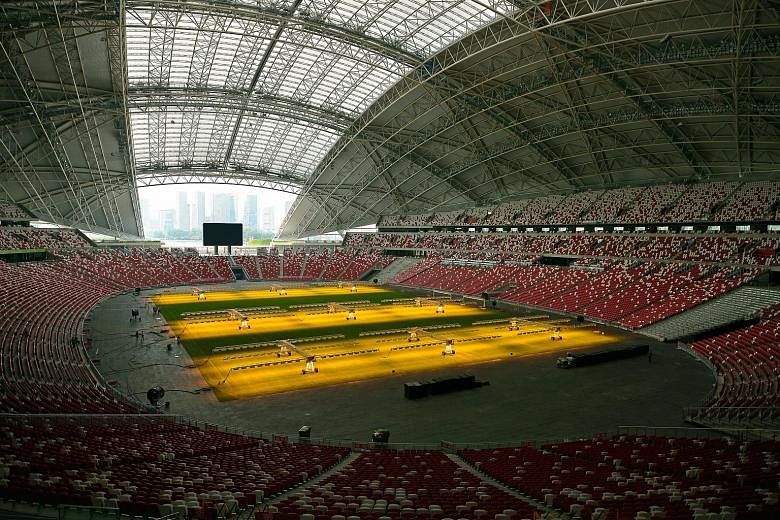So Singapore will turn 51 under the National Stadium dome after all. Yet, while a potential national public relations crisis may have been averted following Friday's announcement that the National Day Parade (NDP) would return to Kallang, the will-it-won't-it NDP saga has raised more important issues than just where the nation's birthday bash will be held.
That there was a possibility that the NDP would not be held at the nation's showpiece arena over cost issues suggests that the Singapore Government's public-private partnership (PPP) with SportsHub Pte Ltd (SHPL) - which operates the Sports Hub, including the National Stadium - may not quite be working as well as it should.
Granted, a misalignment of public-sector needs and private-sector wants often comes with the PPP terrain. As with PPP models worldwide, some level of misalignment is accepted and managed - as long as it does not become a political problem.
But when doubts over staging a national event as sacred as the NDP can even surface, it is little wonder that observers of this 25-year partnership between the Government and SHPL are worried.
More so when the NDP saga is just the latest misstep in what has been a trying four-year marriage - not exactly encouraging when one considers that there are 21 years of this PPP to go.
The first sign that a marriage isn't quite working out is when both parties start airing their grievances in public. Then comes the inability to see eye to eye on seemingly basic things like hosting a birthday party.
Sounds familiar?
Many would recall the stern response from Sport Singapore chief executive Lim Teck Yin at the height of the stadium's much-publicised field problems in October last year. Calling the sub-standard pitch a "significant disappointment", he said that
Sport Singapore would hold SHPL "accountable for the outcomes of their next actions". In response, Sports Hub chief operating officer Oon Jin Teik replied that it would be "pointless for us to get into a war of words with Sport Singapore".
Then came the NDP issue - where negotiations hit a snag when NDP organisers requested an extra 35 days on top of the 45 stipulated in the contract. They were met with commercial rates in the region of $26 million.
If one wants to take it back further, a lack of clear communication was already apparent in 2013 when SHPL solicited and secured naming-rights sponsorship for the Sports Hub as an entity, only to be told that it was never an option. Sizeable revenue went out of the window, income that would not only go towards appeasing SHPL's board - after all, the consortium's interest was always primarily commercial - but would also go into a fund that would help pay for community events at the Hub.
TIME FOR A RETHINK?
With so many major issues arising in just the first four years, it begs the question: Is it time to relook the Sports Hub model?
One possible change would be for the Government to buy out the remainder of the 25-year contract and run the Sports Hub.
That option, though, can be quickly dismissed. The reason the project was a PPP in the first place was that it was clear that to make the National Stadium commercially viable and to ensure the venue's calendar would be filled with both sporting and entertainment events, private-sector expertise would be crucial.
The old National Stadium, run by the public sector, was not exactly buzzing with activity. Likewise, The Float@Marina Bay, also run by the Government, was very much under-utilised, given its premium location.
In short, to make the Sports Hub thrive, conventional wisdom had it that private-sector experts who deal with concert and sports promoters on a daily basis would better benefit the project.
In the same vein, the option of having the project fully managed
by the private sector is also a non-starter - not for a national symbol like the National Stadium where the interest of the nation must be a key factor.
THREE POSSIBLE SOLUTIONS
This then leaves us with three realistic solutions.
Option one: Keep the status quo. After all, this was what the architects of the contract intended it to be. But for this option to succeed, it would require everyone to agree to pull in the same direction. Communication is key. Both public and private have to embrace the partnership aspect of the PPP deal - which, if the events of the last few years are anything to go by, suggest that has not always been the case.
Recent developments may also have raised doubts about the effectiveness of the status quo.
Questions were asked on whether the National Stadium was pricing itself too high, following the breakdown in negotiations for two events that were scheduled to take place at Kallang next year - the Merlion Cup football tournament and the Asia Masters Athletics Championships.
The collapse of the Merlion Cup deal is especially worrying as it now puts a big question mark over the organiser MP & Silva's future events at the Hub. MP & Silva was expected to bring more than 20 events over six years to the Hub, as part of a deal it had with the Football Association of Singapore to create new revenue streams for the local game.
That SHPL took the surprising move of telling two members of the Sports Hub's senior management - Mr Mark Collins, managing director of Global Spectrum Pico (GSP), and Ms Daphne Letournel, director of contracts and compliance - to step down on Friday also leads to speculation that all is not well at the Hub.
GSP, which hires over 300 staff in Singapore, is one of four equity partners that make up the Sports Hub consortium. The others are InfraRed Capital Partners, Dragages Singapore and DTZ Facilities and Engineering.
Steps need to be taken now to ensure all are on the same page. If equity partners cannot agree on the direction of the project, the NDP disagreement certainly won't be the last. In the worst-case scenario, the PPP agreement may even need to be renegotiated, which will be both costly and messy.
Option two: The Government buys out SHPL, takes over the ownership of the Sports Hub and outsources some of the management of the facility to the private sector.
This would give the state total control over programming and scheduling, and the assurance that community-centric events like the NDP and national sporting championships are at the core of its plans, if it so desires. As landlord, it could pay agents a commission to bring events in and manage them.
With a possible restructuring of public transport being mooted, the Government taking over ownership of the infrastructure may not be as far-fetched an idea as it was a few years ago. But taking over the $1.33 billion Sports Hub would require a large investment.
Option three: The Government or a government-linked company invests some fresh capital and also gets one or more seats on the SHPL board. This would give it some control over management decisions without a wholesale takeover.
Given the current situation, this seems to be the neatest of the three options.
While the Government - by way of Sport Singapore - regularly meets SHPL over operational and programming matters, it is not involved in key decision-making processes.
Given how the project is badly in need of a re-alignment and a better marriage of public-private sector wishes, this could be the ideal case.
The Government could be clued in early on important matters, help provide direction and advice and raise alarm bells when needed.
Some capital investment would also allow SHPL, already set back by the investment in the problematic field, to be in a better position to invest in both hardware and software for the Sports Hub.
One welcome fix would be the less-than-satisfactory acoustics at the stadium. Currently, sound escapes through the opening in the stadium, nearest to Kallang Wave Mall. Sealing the opening would provide for better acoustics during concerts. It would also shield fans seated in the area from rain. Both the poor sound and lack of shelter have been among the gripes of visitors to the stadium.
But perhaps, more importantly, having a seat at the board table will assure Singaporeans that the interest of the nation - in what in many ways is one of the state's most iconic national projects - is well looked after.


